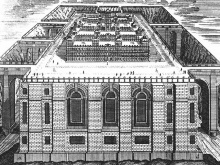The history of representational techniques in architecture coheres with the development of perspective drawing based on projective geometry. Our perception of space is inseparably connected to the techniques of geometric description and its two-dimensional representations. The historic development of theories of spatial perception as well as the interdependence to its various representations through projections form the core of the seminar.
Perspective representations of space are constructed through projective techniques. They do not represent space as it is perceived by the human eye - like a common opinion amongst academics seems to suggest. Perspective techniques, other than the 1-point perspective, document a more comprehensible spatial description. Our visual perception of space and our understanding of space are expressed through the use of corresponding projection techniques.
A fundamental thesis of Robin Evans seminal book The Projective Cast - Architecture and Its Three Geometries is that the techniques of projective geometry and the resulting drawings have a profound impact on our conception and perception of space. In this seminar, this thesis forms the basis of analyzing different kinds of perspectives and examining the related techniques of projective geometry. The aim is to develop a critical view on one's own conception of space as the basis for architectural design.


